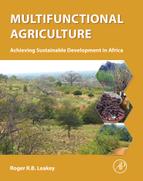Section 9. Integrating Rural Development to Deliver Multifunctional Agriculture
In the context of sustainable intensification, this final chapter attempts to pull together all the data, information, and concepts presented in the previous chapters, combining elements of agroecology, organic farming, permaculture, and modern industrial inputs within agroforestry, as the delivery mechanism for multifunctional agriculture. This approach recognizes the fact that many African smallholders operate on very small farms as self-sufficient units virtually outside the cash economy—and unlike their industrialized country counterparts, they do not function as a business.
This chapter draws heavily on a 12-year case study in Cameroon where many of the strategies, techniques and concepts presented in previous chapters were developed and tested. It is truly a multi- and transdisciplinary study focused on the concepts of multifunctional agriculture, and has delivered on many of these. It is, however, just the start, a beginning toward a different way of thinking about the needs of Africa—needs that span from putting food onto people’s plates and money into their pockets and go all the way up the value chain to the development of new industries. Interestingly, many of these new industries could be founded on a wide array of new crop products developed from species that most people in industrialized countries have never even heard about. This approach was advocated by farmers in Cameroon when they were asked what they would like from agriculture. Subsequently, the program that emerged was developed, led, and implemented by African researchers and their partners in NGOs and local communities and farming households.
The untapped potential of Africa is enormous; I just hope and pray that future upscaling of what is presented here will be done in a way that benefits Africans. We must learn from past mistakes and engage a very different mindset: one that levels up the inequalities which currently divide our world into rich and poor. This new mindset should also eliminate the “silo” mentality that tries to squeeze tropical smallholders into economic theories designed for market economies in which farms are large and have access to income, capital and/or credit, land ownership, and price information. This, it could be said, would integrate Homo sapiens within the management and functioning of intensified agroecosystems around the world.
The final commentary to this book concludes that developing a sustainable and multifunctional approach to the intensification of agriculture is much less expensive, but more multidimensional, than that of annual monocultures. However, for policymakers and development agencies it is knowledge intensive, and requires an understanding of techniques and strategies that cut across a number of academic disciplines. This calls for agricultural science education to broaden the range of disciplines taught to students.
